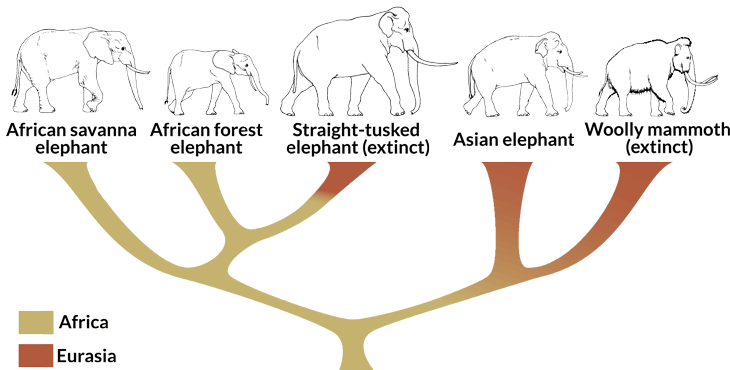The first DNA analysis of ancient straight-tusked elephant fossils may be changing what we know about elephant evolution.
Scientists have presumed that a species of giant elephant called Palaeoloxodon antiquus, which roamed across Europe and Asia over 30,000 years ago, was most closely related to Asian elephants. New research by a multi-institutional team shows that the species’ closest modern relative is actually the African forest elephant.
Moreover, this extinct species, known as straight-tusked elephants, is more closely related to the African forest elephant than the forest elephant is to its nearest living relative, the African savanna elephant.
Key to the discovery is new genetic techniques that enable scientists to analyze an increasingly varied range of biological material, including fossils more than 100,000 years old. Most genetic material this old is decayed and no longer viable for analysis.
“Up until now, genetic research on bones that are hundreds of thousands of years old has almost exclusively relied on fossils collected in permafrost,” said lead author Matthias Meyer, a researcher at the Max Planck Institute for Evolutionary Anthropology, in a media release. “It is encouraging to see that recent advances in laboratory methods are now enabling us to recover very old DNA sequences also from warmer places, where DNA degrades at a much faster rate.”
Employing DNA Sequences to Enhance Our Understanding of Animal Evolution
The researchers extracted and analyzed DNA from the bones of four straight-tusked elephants found at two sites in Germany. A field team collected the bones from a lake basin and a mining quarry, where they had been covered by sediment that preserved them.
In their paper, the authors credited recent advances in ancient DNA extraction and sequencing library construction with the improved access they had to highly degraded DNA. The new techniques allowed the scientists to recover full mitochondrial genomes from four straight-tusked elephant fossils and partial nuclear genomes from two fossils.
The researchers analyzed the bones’ mitochondrial DNA (mtDNA), which is identical among maternal relatives because it passes only from mothers to their offspring with few mutations. This feature allows researchers to trace a direct genetic line. Comparing two mtDNA samples will also show the level of kinship of two animals.
The high rate of mutation (where one nucleotide is replaced with another) in mtDNA, compared to nuclear DNA, makes it easier to distinguish between closely related individuals. The relatively low rate of recombination (mixing sections of DNA from the mother and father) in mtDNA makes the genetic history stable over longer periods of time, making it possible for scientists to build a species’ evolutionary tree.
mtDNA is also found in high numbers within the cells and is well protected. Therefore, it is more likely than nuclear DNA to survive after a long period of time, making it more suitable than nuclear DNA for analyzing old or decomposed fossils.
The scientists compared the ancient DNA to the genomes of woolly mammoths and all three living elephants—African savanna, African forest, and Asian—and found that it was most similar to the genetics of African forest elephants. They confirmed their findings through analysis of the fragments’ nuclear DNA, which blends maternal and paternal genes.
A New Elephant Family Tree
The results suggest that this extinct species has been lumped in with the wrong elephant lineage for decades.

(Photo: Meyer et al./Mongabay)
“When our data began to reveal that the straight-tusked was actually sister to the African forest elephant, we started to realize that this study was basically redrawing the evolutionary tree for elephants,” said Michael Hofreiter, one of the study authors.
The researchers use their findings as an example of the importance of obtaining DNA sequences from both living and extinct species for understanding animal evolution. The genetic analysis contradicts earlier studies that relied on the shapes of bones of the various elephant lineages to categorize them. Palaeoloxodon individuals had high foreheads and double-domed skulls similar to modern Asian elephants.
“From the study of bone morphology, people thought Palaeoloxodon was closer to the Asian elephant,” said research scientist Yasuko Ishida, one of the authors. “But from the molecular data, we found they are much closer to the African forest elephant.”
In their paper, the authors conclude that their results demonstrate that current thinking on elephant evolution is in need of substantial revision. They call for a re-examination of fossil morphology—skeletal form and structure—across the elephant ancestors.
A separate research team has begun re-examining the skeletal features of the straight-tusked elephants and will compare those with this new information on their DNA.
Adrian Lister, a paleobiologist at the Natural History Museum in London working on this comparison, commented to Science: “I will feel most comfortable if we can understand these genetic relationships in terms of the [physical, e.g. skeletal] differences between all these species…. Then we’ll have a complete story.”
The findings also indicate that ancestors to modern African elephants dispersed out of Africa to Eurasia, as did those of mammoths and modern Asian elephants, around 750,000 years ago.

(Photo: Meyer et al./Mongabay)
Support for Two African Elephant Species
The findings also add evidence to the increasingly accepted argument that there are two elephant species in Africa, not just one.
The current study revealed that a common ancestor of P. antiquus and the African forest elephant lived sometime between 1.5 million and 3.5 million years ago. Ancestors of African savanna elephants are thought to have split off from this group between 3.9 and 7 million years ago.
The separation of African forest and savanna elephants has been proposed, debated, confirmed, and then proposed and debated again. Acceptance of this distinction may affect how conservation efforts prioritize populations.
“More than two-thirds of the remaining forest elephants in Africa have been killed over the last 15 years or so,” said co-author Albert Roca of University of Illinois. “Forest elephants are among the most endangered elephant populations on the planet. Some conservation agencies don’t recognize African forest elephants as a distinct species, and these animals’ conservation needs have been neglected.”
Roca led a study in the early 2000s that provided the first genetic evidence separating African forest elephants from savanna elephants. Subsequent research has supported the split into two species, but the conservation community has not fully accepted this conclusion.
This story originally appeared at the website of global conservation news service Mongabay.com. Get updates on their stories delivered to your inbox, or follow @Mongabay on Facebook, Instagram, or Twitter.





